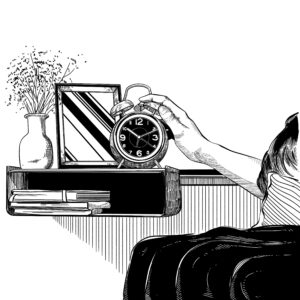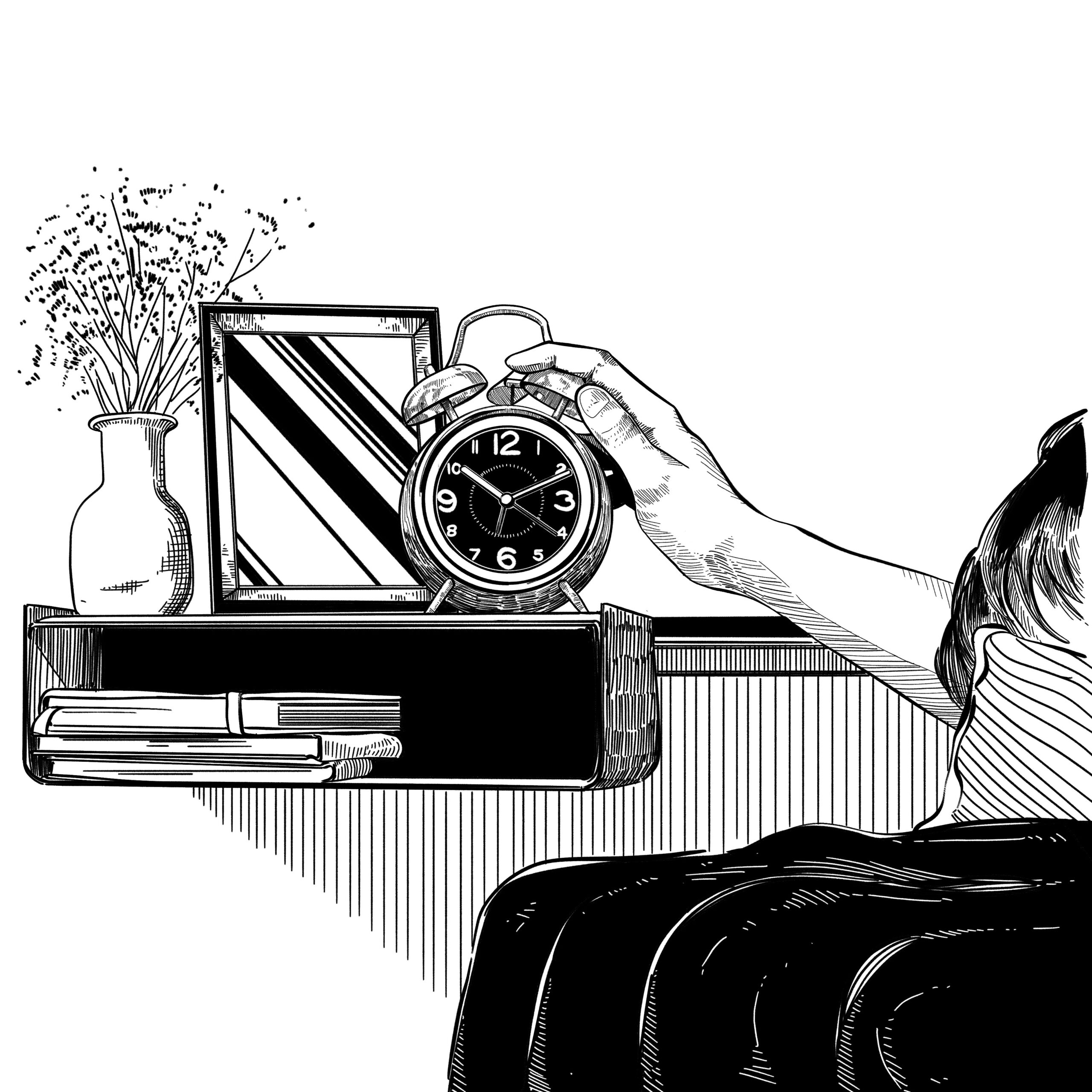Here, we’ll go far beyond the usual “how to” tips that are clogging Google’s search engines. Chances are, you already know about (and have likely already tried) them anyway, and with little success. If something as basic as arrive home earlier or stop scrolling through social media before bed or just find your inner motivation actually worked, there wouldn’t be a need for me to contribute anything new to the conversation. Yet here we are.
In this article, we’ll explore why these tips rarely work, and why having a concrete plan of action is so important when it comes to forming a new habit. On top of this, we’ll offer tips that will help you to build the habit of becoming an early riser.
The Real Reason You Can’t Break Away from Your Snooze Button
You have the motivation (and, most likely, plenty of it). What you don’t have is a game-plan for when and how to wake up early tomorrow morning.
With a strategy in place, there’ll be no need to fight the temptation to hit your snooze button when your alarm goes off; you can simply follow your plan.
Though it might sound a little over the top – to have a concrete plan just to wake up earlier – it is that very plan that will enable you to become an early riser.
If you’re still with me (and I hope that you are), the following tips will help you to change your life by developing your own plan of action for how to wake up earlier tomorrow.
Okay, enough of the preliminaries, let’s jump right in.
Tip #1: Don’t tell yourself, “I will wake up early tomorrow” because it won’t work. Although it may seem counter-intuitive, the best place to start is by asking yourself one simple question.
While goals like “I want to try harder to get out of bed earlier” or “I want to join the 6 a.m. club” are worthy targets, they don’t provide you with clear direction on how and when to act on your goal.
Most people (myself included) go through extensive trial and error to make habits stick, because they have no clear and specific plan for when and how to perform a new habit. And for a difficult-to-form habit, such as waking up earlier, it will be much easier to do when you have a plan mapped out ahead of time.
That’s why I recommend asking yourself, “What’s my plan for getting out of bed?” (Spoiler alert, the answer is harder to come up with than you might think). Tips 2 – 3 (below) will help you to come up with your own step-by-step plan on how to get up tomorrow.
Tip #2: Identify what you do right after your alarm goes off.
On a piece of paper, write down the following formula*:
After I do [current habit], I will add [new habit] to it.
From here, in place of [current habit], you’ll want to simply add the activity (e.g., action) you are already doing when your alarm goes off in the morning.
For example, when my alarm would go off, I would groggily reach for my iPhone to silence it. Once I realized this, my [current habit] looked like this:
After I [silence my alarm] in the morning, I will add [new habit].
This approach is built upon James Clear’s “habit stacking” formula in Atomic Habits, namely: After I do [current habit], I will add [new habit] alongside it (2018, pg. 74).

Tip #3: Write clear instructions for how you’re going to get out of bed.
On the same piece of paper, using the same formula, add your new, desired habit (which is to get out of bed without hitting snooze).
At this stage, your plan should look like this:
After I [turn off my alarm] in the morning, I will [get out of bed without hitting “snooze”].
Having a plan in place for how you’re going to act on your new habit is extremely helpful. That’s because when it’s time to act on your habit, the only thing you need to do is follow through on your instructions (e.g., get out of bed). Any uncertainty is out the window, as you already know what you need to do the moment the alarm goes off.
Simply follow your plan.
Tip #4: Outline the exact steps you’ll be taking to get out of bed after you hit “snooze” using James Clear’s “Two-Minute Rule.”
According to the “Two-Minute Rule,” when you’re trying to form a new habit, it should take less than two minutes to carry out.
Why? Because when something can be immediately implemented, it’s much easier to do, the barriers are removed, and it’s more psychologically appealing.
So, instead of [get out of bed without hitting snooze], at this point, your plan can look something like this:
After I [turn off my iPhone alarm] in the morning, I will [put both feet on the floor]. The reason this level of specificity works is because putting your feet on the floor is easier to do than lifting your entire body out of bed.
Or,
After I [silence my alarm] in the morning, I will [walk across the room to turn on my lamp]. This works because you need to get out of bed to turn on the light.
Whatever you end up inserting, ensure that it’s a task that requires you to physically leave your bed. (Unfortunately, rolling over and giving your significant other a hug will not work here.)
Tip #5: Immediately reward yourself after you’ve gotten out of bed.
For this tip, the goal is to connect the difficult habit of getting out of bed earlier with something you actually want to do.
The key is to answer this question, “What’s the one thing that I would rather be doing than staying in bed after my alarm goes off?”
Once you figure out what would entice you to leave the comfort of your bed, it is critical to immediately reward yourself after you achieve your goal. This is known as the Cardinal Rule of Behavior Change; namely, what is immediately rewarded is repeated and what is immediately punished is avoided (paraphrasing James Clear).
Tip #6: Buy a wall calendar so that you can note each day you performed your new habit – at a glance.
When you track a habit, you are more likely to stick to it. It’s that simple.
I’ve found that using a wall calendar to track my habits is the most effective form of motivation, as it’s the easiest and quickest indicator of success. Putting an “X” on the calendar whenever I wake up without hitting snooze takes two seconds and the visual element provides me with clear evidence of my progress and reinforces my goal (and ability to fulfill it).
Bonus tip: Don’t miss two days in a row.
Another benefit of using a wall calendar to track your progress is that it becomes a record of your habit streak. Seeing consecutive “X’s” on your calendar will motivate you to keep your streak alive.
That being said, if you miss one day (which, let’s be honest, will happen), try your hardest to not miss waking up the next day. Get right back on track. The more time you miss, the easier it is to justify skipping the next day and falling behind.
Tip #7: Redesign or rearrange your sleep environment.
It’s easier to change a habit, or, in this case, break the bad habit of hitting snooze by putting yourself in a new environment.
Because the goal is to associate your new habit of waking up earlier with a new context, redesigning your environment helps to link your new habit to a new context, making it easier for you to create a routine.
Bearing that in mind, why not try moving to a:
- spare bedroom
- bigger room
- different floor of your house
- living room
Of course, the easiest strategy is to simply rearrange your bedroom. Here are a few quick suggestions:
- Move your bed to the other side of the room
- Place your dresser in a new location
- Choose a new spot for your standing lamp
If you live in a small space (like me) and are unable to rearrange your furniture, you can change the little things such as your curtains, comforter, alarm clock, lighting, or even get a new area rug.
So there you have it: 7 tips you can act on today to kickstart your morning routine and finally become an early riser. Now, I’d like to hear from you. Which tip are you going to try first and how do you think it will change your life? Let me know in the discussion form below.
